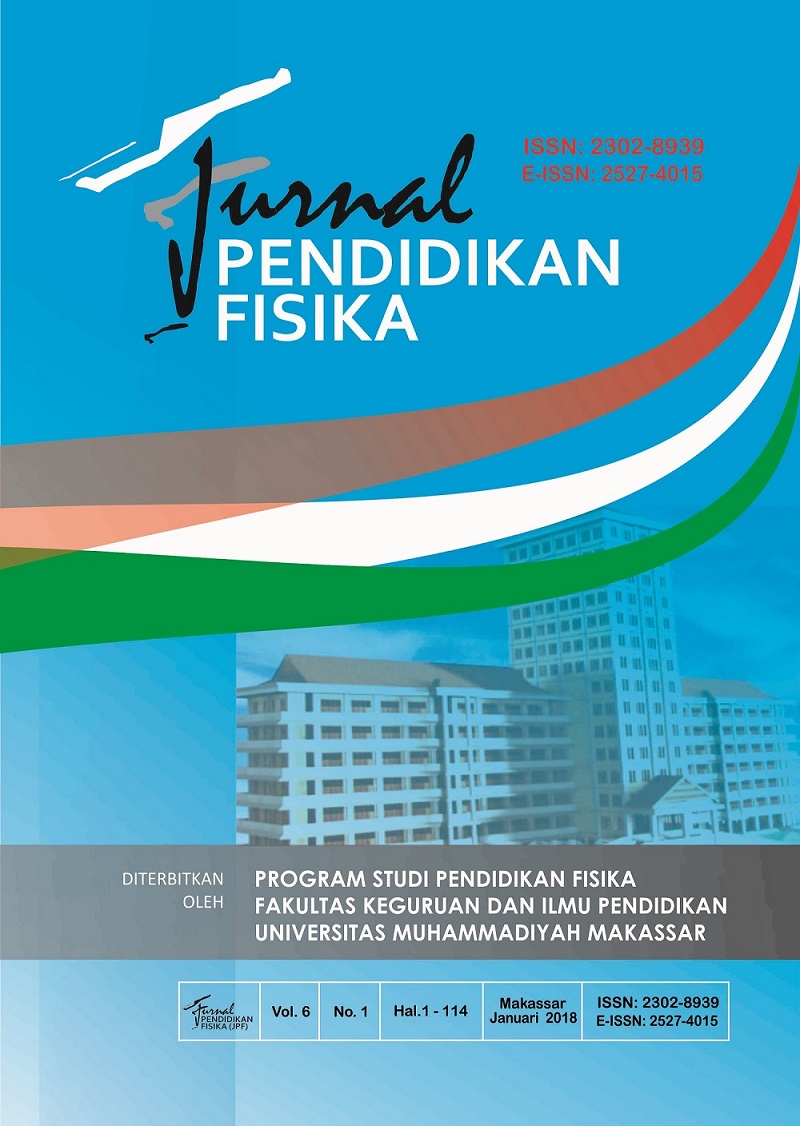Pendekatan Contextual Teaching and Learning (CTL) Berbantuan Media Visual pada Pembelajaran Fisika SMA Materi Gerak Harmonik Sederhana, Usaha dan Energi
DOI:
https://doi.org/10.26618/jpf.v6i1.1200Abstract
Telah dilakukan penelitian yang bertujuan untuk mengetahui hasil belajar fisika sebelum dan setelah diajarkan pembelajaran Contextual Teaching and Learning (CTL) berbantuan media visual serta peningkatan hasil belajar fisika pada peserta didik kelas XI IPA SMA Negeri 2 Pinrang. Jenis penelitian ini adalah penelitian pra-eksperimen yang menggunakan desain The One Group Pretest-posttest yang melibatkan dua variabel terdiri dari variabel terikat dan variabel bebas. Variabel terikat yaitu hasil belajar fisika peserta didik dan variabel bebas yaitu pembelajaran Contextual Teaching and Learning (CTL) berbantuan media visual. Instrumen penelitian yang digunakan adalah tes hasil belajar fisika sebanyak 34 item yang berbentuk multiple choise test pada pokok bahasan “Gerak Harmonik Sederhana, Usaha dan Energi”. Teknik analisis data yang digunakan dalam penelitian ini adalah statistik deskriptif dan uji gain. Sampel penelitian ini berjumlah 32 peserta didik. Hasil penelitian menunjukkan pada pretest peserta didik memperoleh nilai rata-rata hasil belajar sebesar 24,94. Sedangkan pada posttest diperoleh nilai rata-rata sebesar 73,16. Dari perhitungan N-gain diperoleh sebesar 0,64. Sehingga dapat disimpulkan bahwa hasil belajar fisika peserta didik kelas XI IPA SMA Negeri 2 Pinrang meningkat dalam kategori sedang setelah diterapkan pembelajaran Contextual Teaching and Learning berbantuan media visual.
Kata kunci: CTL, media visual, hasil belajar fisika
Research has been conducted that aims to determine the results of physics learning before and after taught Contextual Teaching and Learning (CTL) assisted visual media, as well as improving learning outcomes physics of class XI IPA SMAN 2 Pinrang. This research is a pre-experimental design using The one group pretest-posttest involving two variables consisting of the dependent variable and independent variable. The dependent variable is the result of student physics learning and the independent variable is the learning Contextual Teaching and Learning (CTL) assisted visual media. The research instrument used is physics achievement test as many as 34 items in the form of multiple choise test on the subject "Simple Harmonic Motion, Work and energy". The data analysis technique used in this research is descriptive statistics and test gains. The study sample was 32 students. The results of this study show that in pretest the students get the average value of learning outcome of 24,94. While the posttest obtained an average value of 73,16. From the calculation of N-gain obtained by 0,64. So it can be concluded that the results of physics learning students of class XI IPA SMAN 2 Pinrang increased in the medium category after applied learning Contextual Teaching and Learning (CTL) assisted visual media.
Keywords: CTL, visual media, physics learning outcomesReferences
Hamdani. 2011. Strategi Belajar Mengajar. Bandung: Pustaka Setia
Sudjana, Nana. 2017. Penilaian Hasil Prose Belajar Mengajar. Bandung: Remaja Rosdakarya
Johnson, Elaine. 2014. Contextual Teaching and Learning. Bandung: Kaifa
Sagala, Saiful. 2014. Konsep dan Makna Pembelajaran. Bandung: Alfabeta
Sugiyono, 2016. Metode Penelitian Pendidikan kuantitatif, kualitatif, dan R&D . Bandung : Alfabeta
Arifin, Zainal. 2013. Evaluasi Pembelajaran. Bandung. Remaja Rosdakarya
Meltzer, David. 2003. The relationship Between Mathematics Preparation And Conceptual Learning Gains : A Possible “Hidden Variable” In Diagnostic Pretes Scores. Jurnal Department of Physics And Astronomy, Lowa State University, Ames, Lowa 50011.
Downloads
Published
Issue
Section
License
Copyright:
Authors who publish with this journal agree to the following terms:
1. Authors retain copyright and grant the journal right of first publication with the work simultaneously licensed under a Creative Commons Attribution-ShareAlike 4.0 International License that allows others to share the work with an acknowledgement of the work's authorship and initial publication in this journal.
2. Authors are able to enter into separate, additional contractual arrangements for the non-exclusive distribution of the journal's published version of the work (e.g., post it to an institutional repository or publish it in a book), with an acknowledgement of its initial publication in this journal.
3. Authors are permitted and encouraged to post their work online (e.g., in institutional repositories or on their website) prior to and during the submission process, as it can lead to productive exchanges, as well as earlier and greater citation of published work.
Licence:
Authors are free to:
1. Share: Copy and redistribute the material in any medium or format
2. Adapt: Remix, transform, and build upon the material for any purpose, even commercially.
The licensor cannot revoke these freedoms as long as the authors follow the license terms, which include the following:
1. Attribution: You must give appropriate credit, provide a link to the license, and indicate if changes were made. You may do so in any reasonable manner, but not in any way that suggests the licensor endorses you or your use.
2. ShareAlike: If you remix, transform, or build upon the material, you must distribute your contributions under the same license as the original.
3. No additional restrictions: You may not apply legal terms or technological measures that legally restrict others from doing anything the license permits.
Jurnal Pendidikan Fisika is licensed under a Creative Commons Attribution-ShareAlike 4.0 International License.

